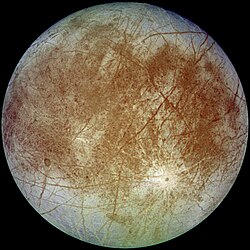Wikijunior:Solar System/Jupiter/Europa
Europa is one of the moons of Jupiter. Europa has an icy surface. Europa is special to scientists as they believe there is an ocean under the ice. Life may live in the ocean. These lifeforms, assuming they exist, would most likely be very different than the lifeforms on Earth, even the aquatic life here. The differences will probably be very random and very large. For example, the lifeforms may have not developed sight as we know it, but could see the radio waves instead, or the micro waves instead of the colour spectrum. They might not even be solid, but liquid or gas!

Europa Facts:
- Europa may have an ocean under its icy surface
- Some scientists think that extraterrestrial life may live in Europa's oceans
- Before this moon's current name, it was simply known as Jupiter II
- This shares a name with an asteroid, 52 Europa, in the asteroid belt
How big is Europa?
[edit | edit source]Europa is 3,122 km (0.246 Earths) across. It would take 125 Europas to equal the weight of one Earth, and almost 67 Europas could be fit into the volume that Earth occupies if they could be molded together like lumps of clay.
What is its surface like?
[edit | edit source]
The Europan surface is extremely smooth; few features more than a few hundred meters high have been seen. There are very few craters on Europa, and only three are more than 5 km wide. This would seem to indicate a young and active surface; based on estimates of the frequency of cometary bombardment Europa probably endures, the surface must be no more than 30 million years old. The smoothness and visible markings strongly resemble that of sea ice on Earth, and it is thought that under the surface there is a layer of liquid water kept warm by tidally generated heat. The temperature on the surface of Europa is far below freezing, even at the equator, so water ice is as hard as rock. The largest craters appear to be filled with flat, fresh ice; based on this and on the calculated amount of heat generated by Europan tides it is predicted that the outer crust of solid ice is approximately 10-30 kilometers thick, which could mean that the liquid ocean underneath may be as deep as 90 kilometers.

Europa's most striking surface feature is a series of dark streaks crisscrossing the entire globe. These streaks strongly resemble the cracks that form in sea ice on Earth, and close examination shows that the edges of Europa's crust on either side of the cracks have moved relative to each other. Another way to look at it is that Europa resembles a cracked eggshell. The larger bands are roughly 20 km across with a central band of lighter material that is thought to have been produced by a series of volcanic water eruptions or geysers as the Europan crust spread open to expose warmer layers beneath. The effect is similar to that seen in the Earth's oceanic ridges. These various fractures are thought to have been caused in large part by the tidal stresses exerted by Jupiter; Europa's surface is thought to rise and fall up to 30 meters between high and low tides. Since Europa is tidally locked to Jupiter- the same side always faces towards Jupiter - the stress patterns should form a distinctive and predictable pattern. However, only the youngest of Europa's fractures conform to the predicted pattern; other fractures appear to have occurred at increasingly different orientations the older they are. This can be explained if Europa's surface rotates slightly faster than its interior, which is possible due to the subsurface ocean separating the moon's surface from its rocky mantle.
It has been suggested that life may exist in this under-ice ocean. Scientists who suggest this point out that life can thrive in similarly harsh conditions on Earth: around deep-ocean hydrothermal vents or in the Antarctic Lake Vostok, which is also under a thick sheet of ice. There is currently no supporting evidence that life exists on Europa, but efforts have nevertheless been made to avoid any possibility of contamination. The Galileo mission was concluded by crashing the spacecraft into Jupiter—if simply abandoned, the unsterilized craft might have eventually crashed into Europa and contaminated it with microorganisms from Earth. This would have made it impossible to determine if Europa ever had its own native life, and could even destroy native organisms if they exist.
Europa's postulated ocean has excited tremendous interest in the scientific community. Just as the Russians have been planning to drill to Lake Vostok in order to sample its water and explore for life, there has been a great deal of speculation about ways to drill through Europa's surface ice to explore it's ocean. Finding life on Europa would be a watershed moment in the history of science.
How long is a day on Europa?
[edit | edit source]It takes 85 hours (3½ Earth days) for Europa to rotate on its axis. It also takes 85 hours for Europa to complete one orbit around Jupiter. Since these numbers are the same, it means that the same side of Europa always faces Jupiter. (Earth's moon is the same way, which is why you can always see the Man in the Moon.)
Who is it named after?
[edit | edit source]
Europa (Greek Ευρώπη) is named after one of Zeus' love interests. Europa was a Phoenician princess who was abducted by Zeus and brought to Crete.
How was it discovered?
[edit | edit source]Europa was discovered by two people: Simon Marius and Galileo Galilei. Galileo discovered it on January 7, 1610. Marius also observed it around the same time.